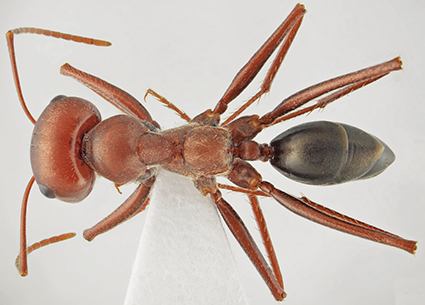Abstract
The comprehensive survey of the ant fauna conducted in Cyprus revealed that the island is inhabited by two species of the genus Cataglyphis Förster, 1850. Both species are endemic and are described as new to science. Cataglyphis chionistrae n. sp., a member of the C. cursor species complex, occurs only in the high montane pine forest of Mt. Chionistra (= Mt. Olympos). While C. aphrodite n. sp., a member of the C. nodus species complex, is common at low and mid altitudes in open habitats or luminous pine forests. This work also provides the key to Cataglyphis from Cyprus and the very first synopsis lists of all the members of the cursor and nodus species complexes known from the Eastern Mediterranean Region.
References
- Agosti, D. (1990) Review and reclassification of Cataglyphis (Hymenoptera, Formicidae). Journal of Natural History, 24, 1457–1505. https://doi.org/10.1080/00222939000770851
- Bolton, B. (2023) An online catalog of the ants of the world. Available from https://antcat.org. (accessed Feb 20 2023)
- Borowiec, L. (2014) Catalogue of ants of Europe, the Mediterranean Basin and adjacent regions (Hymenoptera: Formicidae). Genus, 25, 1–340.
- Borowiec, L. & Salata, S. (2012) Ants of Greece—checklist, comments and new faunistic data (Hymenoptera: Formicidae). Genus, 23, 461–563.
- Brown, W.L. Jr. (2000) Diversity of ants. In: Agosti D et al. (Eds) Ants: standard methods for measuring and monitoring biodiversity. Smithsonian Institution Press, Washington, D.C., 280 pp.
- Collingwood, C.A. (1985) Hymenoptera: Fam. Formicidae of Saudi Arabia. Fauna of Saudi Arabia, 7: 230–302.
- Collingwood, C.A. & Agosti D. (1996) Formicidae (Insecta: Hymenoptera) of Saudi Arabia (part 2). Fauna of Saudi Arabia, 15, 300–385.
- Dempster, J.P. (1957) The population dynamics of the Moroccan locust (Dociostaurus maroccanus Thunb.) in Cyprus. Anti-Locust Bulletin, 27, 1–4.
- Emery, C. (1906) Rassegna critica delle specie paleartiche del genere Myrmecocystus. Memorie della Reale Accademia delle Scienze dell’Istituto di Bologna, (6)3, 47–61
- Eyer, P.A., Seltzer, R. & Reiner-Brodetzki, Hefetz. A. (2016) An integrative approach to untangling species delimitation in the Cataglyphis bicolor desert ant complex in Israel. Molecular Phylogenetics and Evolution, 115, 128–139. https://doi.org/10.1016/j.ympev.2017.07.024
- Forel, A. (1886) Études myrmécologiques en 1886. Annales de la Société Entomologique de Belgique, 30, 131–215.
- Forel, A. (1904) Fourmis du Musée de Bruxelles. Annales de la Société Entomologique de Belgique, 48, 168–177.
- Forel, A. (1910) Glanures myrmécologiques. Annales de la Société Entomologique de Belgique, 54, 6–32.
- Guénard, B., Weiser, M., Gomez, K., Narula, N. & Economo, E.P. (2017) The Global Ant Biodiversity Informatics (GABI) database: synthesizing data on the geographic distribution of ant species (Hymenoptera: Formicidae). Myrmecological News, 24, 83–89. https://doi.org/10.25849/myrmecol.news_024:083
- Ionescu, A. & Eyer, P.A. (2000) Notes on Cataglyphis Förster, 1850 of the bicolor species group in Israel, with description of a new species (Hymenoptera: Formicidae). Israel Journal of Entomology, 46, 109–131. https://doi.org/10.5281/zenodo.221456
- Khalili-Moghadam, A., Salata, S. & Borowiec, L. (2021) Three new species of Cataglyphis Förster, 1850 (Hymenoptera, Formicidae) from Iran. ZooKeys, 1009, 1-28. https://doi.org/10.3897/zookeys.1009.59205
- Kiran, K. & Karaman, C. (2021) Ant fauna (Hymenoptera: Formicidae) of Central Anatolian Region of Turkey. Turkish Journal of Zoology, 45, 161–196. https://doi.org/10.3906/zoo-2008-6
- Kuhn, A., Darras, H., Paknia, O. & Aron, S. (2020) Repeated evolution of queen parthenogenesis and social hybridogenesis in Cataglyphis desert ants. Molecular Ecology, 29, 549–564. https://doi.org/10.1111/mec.15283
- Radchenko A. (2007) Fauna Europea: Formicidae. In: Mitroiu M-D. 2007. Fauna Europea: Vespoidea. Fauna Europaea version 2017.06. [https://fauna-eu.org]
- Radchenko, A. & Paknia, O. (2010) Two new species of the genus Cataglyphis Förster, 1850 (Hymenoptera: Formicidae) from Iran. Annales Zoologici, 60, 69–76. https://doi.org/10.3161/000345410X499533
- Salata, S., Kiyani, H., Minaei, K. & Borowiec, L. (2021) Taxonomic review of the Cataglyphis livida complex (Hymenoptera, Formicidae), with a description of a new species from Iran. ZooKeys, 1010, 117–131. https://doi.org/10.3897/zookeys.1010.58348
- Santschi, F. (1939) Trois notes sur quelques fourmis du Musée Royal d’Histoire Naturelle de Belgique. Bulletin du Musée Royal d’Histoire Naturelle de Belgique, 15(14), 1–15.
- Vigna Taglianti, A., Carpaneto, G.M, Sindaco, R., Audisio, P.A., de Biase, A., Venchi, A., Biondi, M., Bologna, M.A., Fattorini, S., Piattella, E. & Zapparoli, M. (1999) A proposal for a chorotype classification of the Near East fauna, in the framework of the Western Palaearctic region. Biogeographia, 20, 31–59. https://doi.org/10.21426/B6110172
- Wilson, E.O. (1955) A monographic revision of the ant genus Lasius. Bulletin of the Museum of Comparative Zoology, 113, 1–201.
- Wheeler, W.M. & Mann, W.M. (1916) The ants of the Phillips Expedition to Palestine during 1914. Bulletin of the Museum of Comparative Zoology, 60, 167–174.


